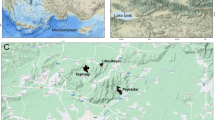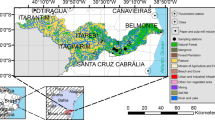Abstract
Primary productivity, community respiration, chlorophyll a concentration, phytoplankton species composition, and environmental factors were compared in the Yolo Bypass floodplain and adjacent Sacramento River in order to determine if passage of Sacramento River through floodplain habitat enhanced the quantity and quality of phytoplankton carbon available to the aquatic food web and how primary productivity and phytoplankton species composition in these habitats were affected by environmental conditions during the flood season. Greater net primary productivity of Sacramento River water in the floodplain than the main river channel was associated with more frequent autotrophy and a higher P:R ratio, chlorophyll a concentration, and phytoplankton growth efficiency (αB). Total irradiance and water temperature in the euphotic zone were positively correlated with net primary productivity in winter and early spring but negatively correlated with net primary productivity in the late spring and early summer in the floodplain. In contrast, net primary productivity was correlated with chlorophyll a concentration and streamflow in the Sacramento River. The flood pulse cycle was important for floodplain production because it facilitated the accumulation of chlorophyll a and wide diameter diatom and green algal cells during the drain phase. High chlorophyll a concentration and diatom and green algal biomass enabled the floodplain to export 14–37% of the combined floodplain plus river load of total, diatom and green algal biomass and wide diameter cells to the estuary downstream, even though it had only 3% of the river streamflow. The study suggested the quantity and quality of riverine phytoplankton biomass available to the aquatic food web could be enhanced by passing river water through a floodplain during the flood season.








Similar content being viewed by others
References
Ahearn DS, Viers JH, Mount JF, Dahlgren RA (2006) Priming the productivity pump: flood pulse driven trends in suspended algal biomass distribution across a restored floodplain. Freshwat Biol 51:1417–1433
American Public Health Association, American Water Works Association and Water Environment Association (APHA) (1998) Standard methods for the examination of water and wastewater, 20th edn. American Public Health Association, Washington, DC, USA
Banaszak AT, Neale PJ (2001) Ultraviolet radiation sensitivity of photosynthesis in phytoplankton from an estuarine environment. Limnol Oceanogr 46:592–603
Caffrey JM, Cloern JE, Grenz C (1998) Changes in production and respiration during a spring phytoplankton bloom in San Francisco Bay, California, USA: implications for net ecosystem metabolism. Mar Ecol Prog Ser 172:1–12
California Bay-Delta Authority Programmatic Record of Decision (CALFED) (2000) The CALFED Bay Delta Ecossytem Restoration Program, Sacramento, CA. http://www.calfed.water.ca.gov/Archives/
Cole BE, Cloern JE (1984) Significance of biomass and light availability to phytoplankton productivity in San Francisco Bay. Mar Ecol Prog Ser 17:15–24
Cole JJ, Caraco NF, Peierls BL (1992) Can phytoplankton maintain a positive carbon balance in a turbid, freshwater, tidal estuary? Limnol Oceanogr 37:1608–1617
Forsberg BR, Araujo-Lima CARM, Martinelli LA, Victoria RL, Bonassi JA (1993) Autotrophic carbon sources for fish of the central Amazon. Ecology 74:643–652
Frenette J-J, Demers S, Legendre L, Dodson J (1993) Lack of agreement among models for estimating the photosynthetic parameters. Limnol Oceanogr 38:679–687
Garcia de Emiliani MO (1997) Effects of water level fluctuations on phytoplankton in a river-floodplain lake system (Parana River, Argentina). Hydrobiologia 357:1–15
Hansen BH, Bjornsen PK, Hansen PJ (1994) The size ratio between planktonic predators and their prey. Limnol Oceanogr 39:395–403
Hein T, Heiler G, Pennetzdorfer D, Riedler P, Schagerl M, Schiemer F (1999) The Danube Restoration Project: functional aspects and planktonic productivity in the floodplain system. Regul Rivers Res Manage 15:259–270
Hein T, Baranyi C, Reckendorfer W, Schiemer F (2004) The impact of surface water exchange on the nutrient and particle dynamics in side-arms along the River Danube, Austria. Sci Total Environ 328:207–218
Heip CHR, Goosen NK, Herman PMJ, Kromkamp J, Middelburg JJ, Soetaert K (1995) Production and consumption of biological particles in temperate tidal estuaries. Oceanogr Mar Biol Annu Rev 33:1–149
Jassby AD (2005) Phytoplankton regulation in a eutrophic tidal river (San Joaquin River, California). San Francisco Estuaries Watershed Sci 3:1–2
Jassby AD, Cloern JE (2000) Organic matter sources and rehabilitation of the Sacramento-San Joaquin Delta (California, USA). Aquat Conserv Mar Fresh Ecosys 10:323–352
Jassby AD, Cloern JE, Cole BE (2002) Annual primary production: patterns and mechanisms of change in a nutrient-rich tidal ecosystem. Limnol Oceanogr 47:698–712
Jassby AD, Kimmerer WJ, Monismith SG, Armor C, Cloern JE, Powell TM, Schubel JR, Vendlinski TJ (1995) Isohaline position as a habitat indicator for estuarine populations. Ecol Appl 5:272–289
Jassby AD, Platt T (1976) Mathematical formulation of the relationship between photosynthesis and light for phytoplankton. Limnol Oceanogr 21:540–547
Junk WJ, Bayley PB, Sparks RE (1989) The flood-pulse concept in river-floodplain systems. In Dodge DP (ed) Proceedings of the international large river symposium. Can Spec Pub Fish Aquat Sci 106:110–127
Keckeis S, Baranyi C, Hein T, Holarek C, Riedler P, Schiemer F (2003) The significance of zooplankton grazing in a floodplain system of the River Danube. J Plank Res 25:243–253
Kemp WM, Smith EM, Marvin-DiPasquale M, Boynton WR (1997) Organic carbon balance and net ecosystem metabolism in Chesapeake Bay. Mar Ecol Prog Ser 150:229–248
Kiss KT (1987) Phytoplankton studies in the Szigetkoz section of the Danube during 1981–1982. Arch Hydrobiol 78. Algol Stud 47:247–273
Langdon C (1988) On the causes of interspecific differences in the growth-irradiance relationship for phytoplankton. II. A general review. J Plank Res 10:1291–1312
Lehman PW (1992) Environmental factors associated with long-term changes in chlorophyll concentration in the Sacramento-San Joaquin delta and Suisun Bay, California. Estuaries 15:335–348
Lehman PW (1996) Changes in chlorophyll a concentration and phytoplankton community composition with water-year type in the upper San Francisco Bay Estuary. In: Hollibaugh JT (ed) San Francisco Bay: the ecosystem. Pac Div Am Assoc Adv Sci, San Francisco, CA, pp 351–374
Lehman PW (2000) Phytoplankton biomass, cell diameter and species composition in the low salinity zone of northern San Francisco Bay Estuary. Estuaries 23:216–230
Lehman PW (2004) The influence of climate on mechanistic pathways that affect lower food web production in northern San Francisco Bay Estuary. Estuaries 27:312–325
Lewis WM Jr (1988) Primary production in the Orinoco River. Ecology 69:679–692
Lewis WM Jr, Hamilton SK, Rodriguez MA, Saunders JF III, Last MA (2001) Food web analysis of the Orinoco floodplain based on production estimates and stable isotope data. J N Am Benthol Soc 20:241–254
Lucas LV, Cloern JE, Koseff JR, Monismith SG, Thompson J (1998) Does the Sverdrup critical depth model explain bloom dynamics in estuaries? Mar Res 56:375–415
Lucas LV, Cloern JE, Thompson JK, Monsen NE (2002) Functional variability of habitats within the Sacramento-San Joaquin Delta: restoration implications. Ecol Appl 12:1528–1547
Mallin MA, Pearl HW (1992) Effects of variable irradiance on phytoplankton productivity in shallow estuaries. Limnol Oceanogr 37:54–62
Menden-Deuer S, Lessard EJ (2000) Carbon to volume relationships for dinoflagellates, diatoms and other protest plankton. Limnol Oceanogr 45:569–579
Muller-Solger AB, Jassby AD, Muller-Navarra DC (2002) Nutritional quality for zooplankton (Daphnia) in a tidal freshwater system (Sacramento-San Joaquin River Delta, USA). Limnol Oceanogr 47:1468–1476
Neale PJ, Talling JF, Heaney SI, Reynolds CS, Lund JWG (1991) Long time series from the English Lake District: irradiance-dependent phytoplankton dynamics during the spring maximum. Limnol Oceanogr 36:751–760
Orsi JJ, Mecum WL (1996) Food limitation as the probable cause of a long-term decline in the abundance of Neomysis mercedis the opossum shrimp in the Sacramento-San Joaquin Estuary. In: Hollibaugh JT (ed) San Francisco Bay: the ecosystem. Pac Div Am Assoc Adv Sci, San Francisco, CA, pp 375–401
Platt T, Sathyendranath S (1990) Primary production by phytoplankton: analytic solutions for daily rates per unit area of water surface. Proc Royal Soc London B 241:101–111
Reynolds CS (1997) Vegetation processes in the pelagic: a model for ecosystem theory. In: Kinne O (ed) Excellence in ecology. Ecology Institute Nordbünte, Germany
Rudek J, Cloern JE (1996) Planktonic respiration rates in San Francisco Bay. In: Hollibaugh JT (ed) San Francisco Bay: the ecosystem. Pac Div Am Assoc Adv Sci, San Francisco, CA, pp 289–304
SAS Institute, Inc (SAS) (2004) SAS/STAT User’s Guide, Version 8. SAS Institute Inc., SAS Campus Drive, Cary, NC, USA
Schemel LE, Cox MH (2007) Floodwater chemistry in the Yolo Bypass during winter and spring 1998. US Geological Survey Open File Report 2007–1025
Schemel LE, Sommer TR, Muller-Solger AB, Harrell WC (2004) Hydrologic variability, water chemistry, and phytoplankton biomass in a large floodplain of the Sacramento River, CA, USA. Hydrobiologia 513:129–139
Smith EM, Kemp WM (2001) Size structure and the production/respiration balance in a coastal plankton community. Limnol Oceanogr 46:473–485
Sobczak WV, Cloern JE, Jassby AD, Muller-Solger AB (2002) Bioavailability of organic matter in a highly disturbed estuary: the role of detrital and algal resources. Proc Natl Acad Sci USA 99:8101–8105
Sommer T, Harrell B, Nobriga M, Brown R, Moyle P, Kimmerer W, Schemel L (2001a) California’s Yolo Bypass: evidence that flood control can be compatible with fisheries, wetlands, wildlife, and agriculture. Fisheries 26:6–16
Sommer TR, Nobriga ML, Harrell WC, Batham W, Kimmerer WJ (2001b) Floodplain rearing of juvenile Chinook salmon: evidence of enhanced growth and survival. Can J Fish Aquat Sci 58:325–333
Sommer TR, Harrell WC, Kurth R, Feyrer F, Zeug SC, O’Leary G (2004a) Ecological patterns of early life stages of fishes in a large river-floodplain of the San Francisco estuary. Am Fish Soc Symp 39:111–123
Sommer TR, Harrell WC, Mueller Solger AB, Tom B, Kimmerer W (2004b) Effects of flow variation on channel and floodplain biota and habitats of the Sacramento River, California, USA. Aquat Conserv Mar Freshwater Ecol 14:247–261
Tockner K, Pennetzdorfer D, Reiner N, Schiemer F, Ward JV (1999) Hydrological connectivity, and the exchange of organic matter and nutrients in a dynamic river-floodplain system (Danube, Austria). Freshwater Biol 41:521–535
United States Environmental Protection Agency (US EPA) (1983) Methods for Chemical Analysis of Water and Wastes. Technical Report EPA-600/4-79-020. United States Environmental Protection Agency, Washington, DC, USA
United States Geological Survey (USGS) (1985) Methods for determination of inorganic substances in water and fluvial sediments. United States Geological Survey. Open file report 85-495
Unrein F (2002) Changes in phytoplankton community along a transversal section of the Lower Parana floodplain, Argentina. Hydrobiologia 468:123–134
Utermöhl H (1958) Zur Vervollkommung der quantitativen Phytoplankton-methodik. Mitt Int Ver Theor Angew Limnol 9:1–38
Van den Brink FWB, Van Katwijk WM, Van der Velde G (1994) Impact of hydrology on phyto- and zooplankton community composition in floodplain lakes along the Lower Rhine and Meuse. J Plank Res 16:351–373
Van den Brink FWB, De Leeuw JPHM, Van der Velde G, Verheggen GM (1993) Impact of hydrology on the chemistry and phytoplankton development in floodplain lakes along the Lower Rhine and Meuse. Biogeochemistry 19:103–128
Vollenweider RA (1974) A manual on methods for measuring primary production in aquatic environments. International biological program handbook, vol 12. Balckwell Scientific Publications, Oxford
Ward AK, Wetzel RG (1980) Photosynthetic responses of blue-green algal populations to variable light intensities. Archiv Hydrobiol 90:129–138
Acknowledgments
This research was funded by research grants from the Sacramento-San Joaquin River Interagency Ecological Program Special Studies Program and the California Bay-Delta Authority (CALFED). Technical assistance was provided by W. Harrell and his staff.
Author information
Authors and Affiliations
Corresponding author
Rights and permissions
About this article
Cite this article
Lehman, P.W., Sommer, T. & Rivard, L. The influence of floodplain habitat on the quantity and quality of riverine phytoplankton carbon produced during the flood season in San Francisco Estuary. Aquat Ecol 42, 363–378 (2008). https://doi.org/10.1007/s10452-007-9102-6
Received:
Accepted:
Published:
Issue Date:
DOI: https://doi.org/10.1007/s10452-007-9102-6




